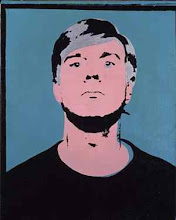 |
| Philip Guston, Head and Bottle, 1975 |
What an extraordinary painter Philip Guston was. Born in 1913 he was of the same generation as Jackson Pollock - in fact he and Pollock became friends when they studied at the same college in the late 1920s - and, like Pollock, Guston became a successful and respected Abstract Expressionist in the 1950s. Yet in the 1960s he abandoned abstraction in favour of figuration, deploying a completely original, seemingly crude, cartoon-like iconography of clocks, bottles, shoes, light bulbs, books and paint brushes, and a one-eyed, disembodied head - taken to represent the artist himself. It is hard now to appreciate what a brave, even outrageous, move this was - Peter Schjeldahl writing in 1984 recalled his own response: "I hated it. It seemed a rank indecency, a profanation, a joke in the worst conceivable taste". As he further recounts, gradually "my resistance disintegrated, and the very paintings I had abhorred started giving me surges of pleasure ." Guston is a 'painter's painter' - the eyes of those to whom I mentioned this show lit up when they heard his name; Schjeldahl, again: "The paint-handling is beautiful, with a beauty that in the comfortless context [of the iconography] is heartbreaking." Guston eventually became a key influence on a generation of 'neo-expressionists' emerging in the 1980s.
This small show brings together some wonderful paintings, including a late abstraction - Traveler III, and some very fine examples of his 'neo-expressionist' work from 1969 up to 1979 (Guston died in 1980) and a selection of ink and charcoal drawings.
Read reviews by Adrian Searle and Fisun Güner.
(Peter Schjeldahl quotes are from his essay on Guston in "Art of Our Time: The Saatchi Collection", vol.3, London: Lund Humphries (1984), pp12-13)
 |
| Philip Guston, Traveler III, 1959-60 |
 |
| Philip Guston, The Hill, 1971 |
 |
| Philip Guston, Frame, 1976 |
 |
| Philip Guston, Story, 1978 |
 |
| Installation view of drawings and small works by Philip Guston at Timothy Taylor |


No comments:
Post a Comment